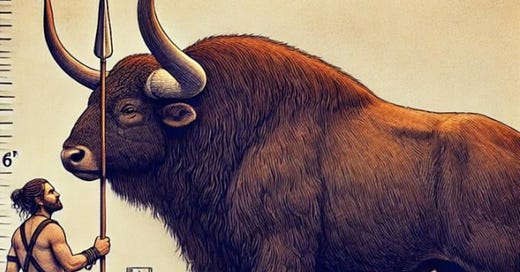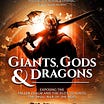Göbekli Tepe, often called the world's oldest temple, reveals itself as an ancient point of connection between humans and the divine. Despite limited excavation, evidence strongly suggests a spiritual and cultural significance tied to interactions with gods.
This conversation explores Göbekli Tepe's importance, highlighting possible supernatural influences, biblical connections, and the symbolic meanings embedded within artifacts like the vulture stone. Recent findings, such as signs of habitation and alignment with archaeoastronomy, are considered alongside ongoing research that continues to uncover the site's mysteries.
We delve into Göbekli Tepe's historical and spiritual dimensions, emphasizing links to biblical narratives and supernatural beings known as the Watchers. They discuss the site's role in ancient burial traditions and its astronomical significance. The conversation also connects Göbekli Tepe to humanity's origins through Adam and Eve, underscoring the site's broader implications for ancient history and modern biblical scholarship.
Watch the interview on the Iron & Myth podcast with Derek Gilbert as we discuss this topic.
Click here to watch the video.
Click below to listen to the audio version.
Get the new book “Decoding Göbekli Tepe” here. Now available on Kindle!
The Anunnaki
The earliest known usages of the term Anunnaki come from inscriptions written during the reign of Gudea and the Third Dynasty of Ur. In the earliest texts, the term is applied to the most powerful and important deities in the Sumerian pantheon: the descendants of the sky-god An in which the name Anunnaki is derived. The name has many variations in spelling and are known from cuneiform sources meaning "princely offspring" or "offspring of An". From the Middle Babylonian Period onward, the name Anunnaki was generally applied to the deities of the underworld.
The Anunnaki were seven chief gods of the Sumerian pantheon: Anu, the sky god; Enlil, god of the air; Enki, god of the earth; Ninhursag, mother goddess of the mountains; Inanna (Babylonian Ishtar), goddess of sex and war; Sin, the moon god (pronounced “seen”); and Utu, the sun god. They are mentioned in texts found in what is today southeastern Iraq that date back to the twenty-seventh century B.C. The Anunnaki were believed to be the offspring of An and the earth goddess Ki. The oldest of the Anunnaki was Enlil, the god of air and chief god of the Sumerian pantheon. The Sumerians called the god of Eridu, “Enki” (lord of the earth). They believed that, until Enlil was born, heaven and earth were inseparable. Enlil cleaved heaven and earth in two and carried away the earth while his father An carried away the sky. In ancient Mesopotamia, civilizations called the Anunnaki “the mighty men.”
David Rohl writes, “the name “Anunnaki can also be understood as ‘the ones of heaven and earth’- in other words those of the primordial age who came from heaven (an) to settle on earth (ki)” or from the mountains to the alluvial plain. They were mortal men who became gods.”1
The Anunnaki are said to have inhabited a primeval mound called Duku located on a mountain to the north of Mesopotamia called Kharsag (also written Hursag). Kharsag is a Sumerian term variously translated as meaning "mountain", "hill", "foothills" or "piedmont". Kharsag also translates from the Sumerian as head enclosure, and is named from the Kharsag Epics, a series of clay cylinders and tablets, inscribed in cuneiform from the Nippur library.
It is interesting to note that the remaining Kharsag Epic in Tablet 8317 covers a 1,000 year storm, and tablets 19,751, 2,204, 2,270 and 2,302 record the Final Destruction of Kharsag, overwhelmed by flood water. Could this be referring to the flood of Noah’s day and the Younger-Dryas event that lasted for 1,000 years following the great Deluge? The Epic of Atrahasis says it this way- “when the gods were man..” Does this sound familiar? These are the fallen angels who left their first estate written in the book of Jude. It was the gods (fallen angels or the Watchers) who became men and progenerated a demigod offspring- the men of old; men of renown referred to in Genesis 6.
Jude 1:6 “And the angels which kept not their first estate, but left their own habitation, he hath reserved in everlasting chains under darkness unto the judgment of the great day”.-
These Watchers were of the angelic, heavenly realm but left the heavenly places to earth to become the legendary “gods”. These fallen angels left their first estate (habitation) for the earthly, mortal realm to become flesh and blood- physicality. After the rebellion with Lucifer, one third of the “Watchers” descended on Mount Hermon in the days of Jared. They are the “Great Shining Ones”, the Great Sons of Anu who descended - the many Wise Ones of the Heavenly Assembly we just read in the Kharsag Epic. In the book of Enoch, it describes what these “Watchers” were up to. In Derek Gilbert’s book, “The Great Inception”, he expounds on this subject very succinctly.
“The extra biblical books of Enoch and Jubilees expand on the story, adding detail and context that’s not in the Bible. Mount Hermon is where two hundred Watchers, a class of angelic beings mentioned in chapter 4 of the book of Daniel, descended and began cavorting with human women. From these unions came the Nephilim, the giants of Genesis 6. The Watchers, according to Enoch, were led by Semjâzâ, who was apparently worried that he’d take the fall for what they were about to do: And Semjâzâ, who was their leader, said unto them: “I fear ye will not indeed agree to do this deed, and I alone shall have to pay the penalty of a great sin.” And they all answered him and said: “Let us all swear an oath, and all bind ourselves by mutual imprecations not to abandon this plan but to do this thing.” Then sware they all together and bound themselves by mutual imprecations upon it. And they were in all two hundred; who descended ⌈in the days⌉ of Jared on the summit of Mount Hermon. (The Book of Enoch 6:3–6a, R. H. Charles translation)2
With the background in mind, let’s delve back into the activities at Göbekli Tepe. Situated in front of Pillar 9 within Building B, a series of shallow limestone plates with channel grooves were discovered in their original position on the artificial terrazzo floor, which is composed of burnt lime. Excavations conducted in 2000 focused on the older layers of Structure B. This structure features two massive pillars (Pillars 9 and 10) positioned centrally within an enclosure, which is delineated by stone walls and six additional pillars.
In front of Pillar 9, a trapezoidal limestone slab was embedded into the floor. This slab’s surface is not uniform; it includes a shallow channel that extends from the edge into a bowl-like depression at its center. Several other limestone slabs with similar features—runnels and bowl-like depressions—have also been discovered at Göbekli Tepe. These findings strongly suggest their use in ritualistic contexts. Professor Klaus Schmidt, the eminent German archaeologist who led the original excavations at Göbekli Tepe, even speculated about a connection with the Anunnaki. Furthermore, there appears to be a notable link between three other sites—Çayönü, Nevah~Cori, and Karahan Tepe. While there is no concrete evidence of animal or human sacrifices specifically associated with the Anunnaki, the possibility of libations or similar ritualistic offerings cannot be dismissed.
Dr. Michael Heiser, a biblical scholar specializing in the Anunnaki, clarifies:
“There are no known temples specifically dedicated to the Anunnaki for the purpose of worshiping them. Additionally, no texts suggest that offerings were made to the Anunnaki for worship. While certain Mesopotamian temples did include chapels for the Anunnaki and other lesser gods within the pantheon, this arrangement was intended for the Anunnaki to worship higher deities. These offerings, as Heiser explains, were made for the benefit of the deceased (‘shade’), not as acts of worship or adoration. In essence, these rituals were not about venerating the Anunnaki but about appeasing them to ensure the spirits of the dead remained at rest.”3
Think about it, if you wanted your relative to enjoy a prosperous afterlife, you appease the gods of the underworld with a big ritual feast and beer. Yes, there is evidence that beer was fermented using wild barley found at the site. People came to this area because of its natural resources in the plain of Harran. They also came to the sacred stones to venerate their forefathers who gave them life and secondly to appease the Anunnaki gods who were the overlords of the dead with the power over them in the afterlife. For example- Ham, Noah’s son was later identified with the sun-god Utu/Shamash in history, Nimrod/Enmerka “the mighty hunter” was elevated to deity status of hunting and warfare called Ninurta and Noah was later remembered by the Egyptians as the original Horus king from whom the pharaohs had descended.
Is it becoming clearer? The people of Göbekli Tepe are considered a pre-agriculture culture because they were gathering the wild grains here; perhaps making a home at Göbekli Tepe. Could it be that one of the functions of these mysterious enclosures was to appease the Anunnaki gods on behalf of their dead ancestors? If so, this could explain the “feasting” at the site with thousands of wild animal bones found and fermented beer in the stone vats. This was perhaps a central veneration site of life and death. Birth and rebirth. The cycle of life. What does this mean? They were participating in ritualistic, feasting ceremonies to venerate their dead ancestors and to appease the Anunnaki gods who gave their ancestors’ life and sacred knowledge.
Final Thoughts
The Kharsag Epic, with its enigmatic verses and references to cataclysmic events, offers a window into an era where deities and humans coexisted and shaped existence itself. Tablet No. 14005 - A vividly portrays the arrival of the Anannage, the Great Sons of Anu, at the sacred mound of Duku on the mountain of Kharsag. In this fertile and abundant setting, the Anunnaki bestowed upon humanity gifts of knowledge and prosperity, guiding them toward enlightenment and abundance.
The intricate rituals and offerings detailed in these ancient texts suggest a profound connection between the earthly and divine realms. Examining the historical narratives, parallels emerge between the Kharsag Epic and biblical accounts such as the flood of Noah and the enigmatic Nephilim. The stories of fallen angels and the Watchers, who descended from the heavens to interact with mortals, offer hindsight into the forbidden knowledge and tumultuous events that shaped these ancient civilizations. Göbekli Tepe, with its monumental pillars and elaborate carvings, also stands as a testament to the enduring link between humanity and the divine.
Dr. Michael Heiser’s scholarly work provides a keen perspective on the relationship between mortals and the Anunnaki, illuminating the intricate rituals and offerings designed to appease these divine beings. The remnants of feasting ceremonies and libations at Göbekli Tepe suggest a profound veneration for both ancestors and ancient gods who influenced the course of human history.
As a token of our appreciation, we're offering you a limited-time offer of 20% off a paid subscription for your first year. Thanks again for reading!
PS. If you loved this article, be sure to head over to our Ancient Pathways Patreon site and download the new Book of Giants Library Volumes 1-3, Joe Taylor Radio: Giants, Fossils, Dinosaurs & Mammoths. Ohh, & Bigfoot.., Judd Burton’s Giant interview on Coast to Coast AM and Joe Taylor’s book “Giants: Against Evolution”.
Also see the film “On the Trail of the Nephilim across Peru & Bolivia”.
PSS. You may also enjoy my prior post
A Brief Survey of the Divine Council
Picture captured from film negative during the aftermath of the Oklahoma City bombing
FOOTNOTES
Rohl, David. (2002). From Eden to Exile: The Five-Thousand-Year History of the People of the Bible. Greenleaf Press, pg. 33.
Gilbert, Derek P. (2016). The Great Inception. Crane, Missouri: Defender Publishing.
Heiser, Dr. Michael S. (2019). The Anunnaki Gods According to Ancient Mesopotamian Sources: English Translations of Important Scholarly Works with Brief Commentary. Blind Spot Press. Kindle Edition.
Dr. Aaron Judkins Substack is a reader-supported publication. To receive new posts and support my work, consider becoming a free or paid subscriber.









